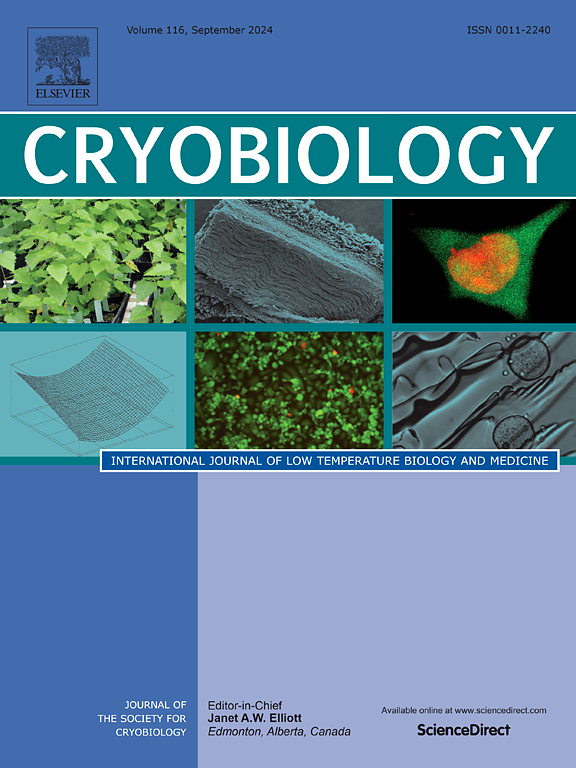F344、Long-Evans和SD菌株的小体积玻璃化和低温快速加热大鼠单细胞胚胎玻璃化
IF 2.3
3区 生物学
Q2 BIOLOGY
引用次数: 0
摘要
基因组编辑动物可以通过将CRISPR/Cas9系统引入单细胞期胚胎,甚至在非小鼠胚胎中创建。我们建立了F344近交系、Long-Evans和SD系大鼠单细胞胚胎的玻璃化冷冻方法。成功的低温保存需要避免细胞内结冰(IIF)。我们假设一种新的冷冻保存方法可以通过快速加热来避免加热过程中的IIF,通过在传统的冷冻管中使用小体积玻璃化和快速加热进行冷冻保存。低温保存的单细胞胚胎在含有15 μL低温保存液(5 μL 5%丙二醇和10 μL PEPeS的混合物)的试管中,加入1 ml 0.3 M蔗糖溶液,在50°C下加热,其受精率为67.2% (F344), 56.3%(龙-埃文思)和65.0% (SD),与非低温保存的对照胚胎的受精率(分别为60.3%,58.3%,67.0%)相当。因此,来自多个菌株的大鼠单细胞胚胎甚至可以通过快速升温的冷冻管进行低温保存。本文章由计算机程序翻译,如有差异,请以英文原文为准。
Rat one-cell embryo vitrification in F344, Long-Evans, and SD strain via small-volume vitrification and rapid warming in cryotubes
Genome-edited animals can be created by introducing CRISPR/Cas9 systems into one-cell stage embryos, even in non-mice embryos. We developed a vitrification method for rat one-cell embryos of the F344 inbred, Long-Evans, and SD strains. Successful cryopreservation requires the avoidance of intracellular ice formation (IIF). We hypothesized that a new cryopreservation method could be developed by rapid warming to avoid IIF during warming, via cryopreservation in conventional cryotubes using small-volume vitrification and rapid warming. When cryopreserved one-cell embryos in a cryotube with 15 μL cryopreservation solution (mixture of 5 μL 5 % propylene glycol and 10 μL PEPeS) were warmed by adding 1 ml of 0.3 M sucrose solution at 50 °C, they developed to term at 67.2 % (F344), 56.3 % (Long-Evans), and 65.0 % (SD), which were comparable with those (60.3 %, 58.3 %, 67.0 %, respectively) of non-cryopreserved control embryos. Thus, rat one-cell embryos from several strains can be cryopreserved even with cryotubes via rapid warming.
求助全文
通过发布文献求助,成功后即可免费获取论文全文。
去求助
来源期刊

Cryobiology
生物-生理学
CiteScore
5.40
自引率
7.40%
发文量
71
审稿时长
56 days
期刊介绍:
Cryobiology: International Journal of Low Temperature Biology and Medicine publishes research articles on all aspects of low temperature biology and medicine.
Research Areas include:
• Cryoprotective additives and their pharmacological actions
• Cryosurgery
• Freeze-drying
• Freezing
• Frost hardiness in plants
• Hibernation
• Hypothermia
• Medical applications of reduced temperature
• Perfusion of organs
• All pertinent methodologies
Cryobiology is the official journal of the Society for Cryobiology.
 求助内容:
求助内容: 应助结果提醒方式:
应助结果提醒方式:


